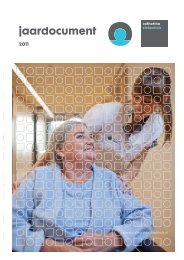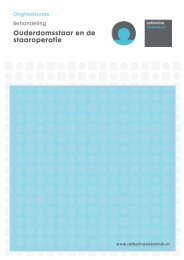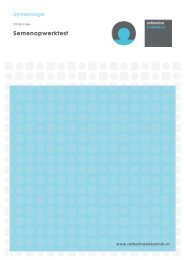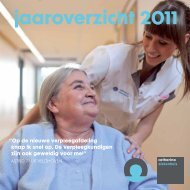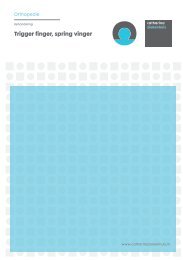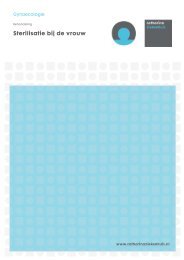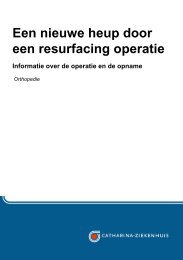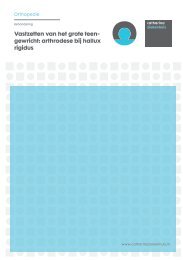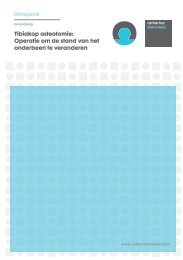- Page 1 and 2: Wetenschappelijk Jaaroverzicht 2012
- Page 3: Inhoudsopgave Woord vooraf 5 Algeme
- Page 7 and 8: Algemeen Klinisch Laboratorium
- Page 9: Boer AK Verbeterde Cushing speeksel
- Page 13: eference thresholds can help to ide
- Page 16 and 17: Beckers A Inadvertent epidural inje
- Page 18 and 19: Maassen RL Forces applied to the ma
- Page 20 and 21: Zundert AA van Carl koller gold med
- Page 22 and 23: to the vocal cords, with actual int
- Page 25 and 26: Apotheek
- Page 27: CONCLUSION: Patients with the CYP2C
- Page 30 and 31: Algin A Tropheryma whipplei aortic
- Page 32 and 33: Bracke FA Pathways for training and
- Page 34 and 35: their first acute STEMI. Estimated
- Page 36 and 37: Hauer HA European survey on efficac
- Page 38 and 39: Koolen JJ A randomized multicenter
- Page 40 and 41: calculated circumferentially in the
- Page 42 and 43: Koolen JJ Head to head comparison o
- Page 44 and 45: Koolen JJ Vascular tissue reaction
- Page 46 and 47: Peels CH Increased septum wall thic
- Page 48 and 49: Pijls NH Instantaneous wave-free ra
- Page 50 and 51: Sels JE Deep proteome profiling of
- Page 52 and 53: functionally significant lesions (F
- Page 54 and 55: The development of hemolysis during
- Page 56 and 57: to establish a translatable model o
- Page 58 and 59: occurrence during daylight. AMI occ
- Page 60 and 61:
Berreklouw E Inability to ventilate
- Page 62 and 63:
tested. Survival in different risk-
- Page 64 and 65:
Soliman Hamad MA Can the EuroSCORE
- Page 66 and 67:
Straten AH van A pulmonary shadow a
- Page 68 and 69:
Straten AH van Left bundle-branch b
- Page 70 and 71:
acute myocardial infarction (AMI) a
- Page 72 and 73:
Woorst FJ ter Results of one-hundre
- Page 74 and 75:
Bendermacher BL Applicability of th
- Page 76 and 77:
meet the criteria also did not diff
- Page 78 and 79:
CONCLUSIONS: Laparoscopic Surgical
- Page 80 and 81:
information supplemented with a mob
- Page 82 and 83:
Hingh IH de Centralisatie pancreasc
- Page 84 and 85:
RESULTS: Some 2155 PDs were include
- Page 86 and 87:
Hingh IH de Peritoneal carcinomatos
- Page 88 and 89:
Jakimowicz JJ Laparoscopic Surgical
- Page 90 and 91:
CONCLUSIONS: CRS and PIC for colore
- Page 92 and 93:
Lauret GJ The ClaudicatioNet concep
- Page 94 and 95:
Luyer MD Stimulation of the autonom
- Page 96 and 97:
Martijnse IS Focus on extralevator
- Page 98 and 99:
treatment. A variety of schemes hav
- Page 100 and 101:
Nienhuijs SW Perineal hernia repair
- Page 102 and 103:
Nieuwenhuijzen GA An abnormal scree
- Page 104 and 105:
Nieuwenhuijzen GA Hormone treatment
- Page 106 and 107:
Nieuwenhuijzen GA Perineal hernia r
- Page 108 and 109:
emergency thoracotomy. Per-operativ
- Page 110 and 111:
esponse (>ypT3a). Also, 27 patients
- Page 112 and 113:
Sambeek MR van Early results from t
- Page 114 and 115:
Smulders JF Indications and short-t
- Page 116 and 117:
Teijink JA Circulating biomarkers a
- Page 118 and 119:
Teijink JA Endovascular treatment o
- Page 120 and 121:
quality of life (physical, mental).
- Page 122 and 123:
Vermeer TA T3+ and T4 rectal cancer
- Page 124 and 125:
Woensdregt K Hormone treatment with
- Page 126 and 127:
Bouten H Anogenital malignancies in
- Page 128 and 129:
Krekels GA Imiquimod 5% cream as pr
- Page 130 and 131:
Roij J van Imiquimod 5% cream as pr
- Page 132 and 133:
Feron JC Clinical evaluation of the
- Page 134 and 135:
Laar EF van de Toekomst van de gees
- Page 136 and 137:
Aa GC van der Effectiveness of deme
- Page 138 and 139:
138
- Page 140 and 141:
Dietz V Can preoperative urodynamic
- Page 142 and 143:
Hasaart TH Anafylaxie na ijzerdextr
- Page 144 and 145:
the tasks, total instrument path le
- Page 146 and 147:
BACKGROUND We recently reported tha
- Page 148 and 149:
and where the prevalence of genital
- Page 150 and 151:
Aarts RP Risk factors for osteoporo
- Page 152 and 153:
152
- Page 154 and 155:
Beijers HJ Clustering of metabolic
- Page 156 and 157:
METHODS: 99mTechnetium-annexin A5 s
- Page 158 and 159:
CONCLUSION: The addition of the thi
- Page 160 and 161:
RESULTS: After adjustment for diffe
- Page 162 and 163:
Konings CJ Poor compliance with gui
- Page 164 and 165:
Pronk MJ Aetiology of acute gastroe
- Page 166 and 167:
attenuated these associations to =0
- Page 168 and 169:
Heerbeek H van Costs of gastroenter
- Page 170 and 171:
Odink RJ Beneficial effects of grow
- Page 172 and 173:
172
- Page 174 and 175:
Hurkmans CW Adaptive radiation ther
- Page 176 and 177:
Participating sites submit data thr
- Page 178 and 179:
ecent RT trials. It is presumed tha
- Page 180 and 181:
CONCLUSION: The only correction met
- Page 182 and 183:
Balkom, RH van Hemoptoë en respira
- Page 184 and 185:
Graat-Verboom L Progression of oste
- Page 186 and 187:
Smeenk FW Churg-strauss-syndroom al
- Page 188 and 189:
METHODS: Descriptive COPD statistic
- Page 190 and 191:
demonstrated in this short-term sig
- Page 192 and 193:
Gilissen LP Uncommon complications
- Page 194 and 195:
endoscopic resection procedures (85
- Page 196 and 197:
196
- Page 198 and 199:
Pijpe J Long term stability of mand
- Page 200 and 201:
Bouwman FH Serial CSF sampling in A
- Page 202 and 203:
METHODS: The Radboud University Nij
- Page 204 and 205:
andomized controlled trials or coho
- Page 206 and 207:
Nuenen BF van∞ "On" state freezin
- Page 208 and 209:
208
- Page 210 and 211:
Pijpers H Lymphatic mapping after p
- Page 212 and 213:
Broek KC van den Posttraumatic stre
- Page 214 and 215:
RESULTS: During this time period, s
- Page 216 and 217:
Houterman S∞ The measurement of u
- Page 218 and 219:
Stepaniak PS Bariatric surgery with
- Page 220 and 221:
Devilee RJ Is the use of autologous
- Page 222 and 223:
Beek M van Lower sensitivity of scr
- Page 224 and 225:
values. Screening strategies were p
- Page 226 and 227:
complications, mainly endocarditis
- Page 228 and 229:
Q fever patients, screening of grou
- Page 230 and 231:
Hoogbergen MM Is the use of autolog
- Page 232 and 233:
232
- Page 234 and 235:
Breest Smallenburg V van Lower sens
- Page 236 and 237:
that screening round. For subsequen
- Page 238 and 239:
Duijm LE Two-view versus single-vie
- Page 240 and 241:
with proven axillary metastases tha
- Page 242 and 243:
Reijnen M Adaptive radiation therap
- Page 244 and 245:
244
- Page 246 and 247:
Berg HA van den Health related qual
- Page 248 and 249:
Lybeert ML Mapping use of radiother
- Page 250 and 251:
Martijn H T3+ and T4 Rectal Cancer
- Page 252 and 253:
Sangen MJ van der Preoperative chem
- Page 254 and 255:
254
- Page 256 and 257:
Buenen N∞ Compensatory activity i
- Page 258 and 259:
Brinkman WM Single versus multimoda
- Page 260 and 261:
Tjiam IM Program for laparoscopic u
- Page 262 and 263:
Anesthesiologie Scheepers-Hoeks AM*
- Page 264 and 265:
Nienaber CA, Willigendael EM*, Akin
- Page 266 and 267:
266
- Page 268 and 269:
Cardiologie Vermeulen Windsant IC C
- Page 270 and 271:
Pamm Wulf MW Epidemiology of livest
- Page 272 and 273:
Presentaties Algemeen Klinisch Labo
- Page 274 and 275:
Reden van staken Aantal Percentage
- Page 276 and 277:
Posters Algemeen Klinisch Laborator
- Page 278 and 279:
ventricular stimulation site by det
- Page 280 and 281:
280
- Page 282 and 283:
Presentaties Algemeen Klinisch Labo
- Page 284 and 285:
Klinische Fysica Unipan, M Minimizi
- Page 286 and 287:
Posters Algemeen Klinisch Laborator
- Page 288 and 289:
measured in both _downstream_ arter
- Page 290 and 291:
and reinterventions within 30-days
- Page 292 and 293:
EVAR without pre-emptive IIA coilin
- Page 294 and 295:
and/orincrease the safety of the us
- Page 296 and 297:
Intensive Care Vonken HJ en Zwaveli
- Page 298 and 299:
Klinische Fysica Kloeze C Significa
- Page 300 and 301:
Maag-darm-leverziekten Sommen F van
- Page 302 and 303:
essential) video observations (90%)
- Page 304 and 305:
304
- Page 306 and 307:
Tabel 1: Overzicht aantal publicati
- Page 308 and 309:
Tabel 3: Overzicht aantal aantal ar
- Page 310 and 311:
Int J Radiat Oncol Biol Phys 4.105
- Page 312 and 313:
Auteursindex Auteur Pagina Auteur P
- Page 314 and 315:
O Smeenk FW 185,265 Odink RJ 169 Sm
- Page 316:
316



